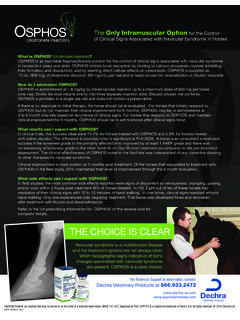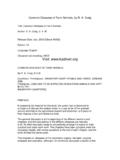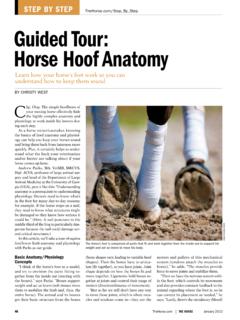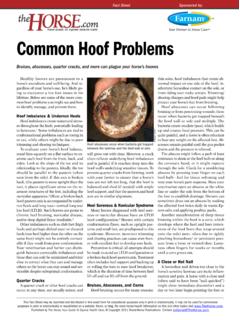Transcription of Navicular Disease in Horses - Equine Veterinary Services
1 1 Navicular Disease in Horses James M. Casey, , Equine Sports Medicine, Dentistry, & Surgery Office: (301) 725-4371 Cell: (301) 785-5167 Website: Navicular SYNDROME Navicular Disease is really a group of related conditions affecting the Navicular bone and associated structures in the foot. There are several possible causes of pain in and around the Navicular bone. Anatomy of the Navicular region The Navicular bone is a small flattened bone, which lies across the back of the coffin joint. It attaches to the pedal bone via a short strong ligament (the impar ligament) and to the pastern joint by suspensory ligaments.
2 The deep digital flexor tendon runs over the lower surface of the Navicular bone, which acts somewhat like a pulley and between these lies a small pocket of fluid, the Navicular bursa, which acts like a cushion between the tendon and its pulley . What causes Navicular Disease ? At present, the exact primary cause of Navicular Syndrome is not known. Damage to the Navicular bone may occur due to interference with blood supply or trauma to the bone. Damage can occur to the deep flexor tendon, Navicular bursa, or Navicular ligaments all resulting in pain and lameness. It is usually not found in very young Horses . It is often found in Horses five years and older.
3 From The Horse's Foot CD ROM Lifelearn Inc. 2 What are the symptoms? Navicular Disease usually affects the front feet of Horses causing a low grade bilateral lameness, which most often progresses slowly. The lameness might only occur from time to time or when the horse is exercised on hard ground or in a small circle. In some cases, one foot is affected more than the other causing an obvious lameness. Affected Horses may stand with the more painful foot in front placed of the other (pointing). How is Navicular Disease diagnosed? Diagnosis is based on a combination of history, symptoms, nerve blocks and radiography.
4 A history of intermittent low grade or recurrent lameness is suggestive of Navicular Disease . Affected Horses often appear to place the toe down first, as if trying not to put weight on their heels (in contrast to laminitis), and the lameness is worse on the inside leg on a circle. Injection of local anesthetic (nerve block) around the nerves sensitizing the back half of the foot and/or into the Navicular bursa will improve or alleviate the lameness associated with Navicular Disease . Some cases also improve when the coffin joint (P2/P3, distal phalangeal or DIP joint) is blocked.
5 Radiographs (x-ray pictures) may reveal damage to the Navicular bone but bone changes can be difficult to interpret, as there are differing opinions on what is normal . Navicular syndrome can exist without demonstrable radiographic abnormality and magnetic resonance imagining (MRI) may reveal injury to the impar or other ligaments or soft tissues. What treatments are available? Navicular Disease can be treated but rarely cured. Corrective trimming and shoeing is important to ensure level foot fall and foot balance. Often a rolled toe egg bar shoe is used to encourage early break over at the toe and good heel support.
6 Medication such as phenylbutazone will elevate pain in many cases and enable work to be resumed. Long term treatment with substances such as isoxsuprine and aspirin may improve blood supply to the Navicular bone and improve the condition of the bone. We can inject the Navicular bursa with Corticosteroids, Intraarticular Adequan, Hyaluronic Acid, and other medications. X-ray (radiograph) of Navicular bone showing chronic change at lower boarder (arrowed) Post mortem specimens of Navicular bones showing chronic damage Injecting the Navicular Bursa 3 A new medication that has recently come available is Tildren.
7 Tildren is currently under going approval in the United States. This medication has been used in Europe and other countries for a number of years. To import Tildren into this country, to use with your horse, currently requires written permission from the FDA (Food and Drug Administration). We can make a request to the FDA to import Tildren for your horse. In my practice I have treated Horses successfully using Tildren. Surgical Intervention: Neurectomy Long term desensitization of the back of the foot can be achieved by performing a neurectomy to cut the heel nerves.
8 This treatment should only be considered as a last resort and then only in full recognition of the implications. Post operative complications include painful inflammation of the cut nerve endings (neuromas) and damage to the foot which can go unnoticed by horse and owner. Once a Neurectomy is performed, the horse s foot must be inspected daily for life. Neurectomy is by no means a 100% cure. In my practice many Horses after a neurectomy have continued to race, show, and gone on to other productive lives. Can Navicular Disease be prevented? Horses with all foot shapes can develop Navicular Disease .
9 Nevertheless, maintaining good foot balance and heel support can help to prevent many foot lamenesses. However not enough is known about the exact cause of Navicular Disease for prevention to be guaranteed. Equine Sports Medicine, Dentistry, & Surgery James M. Casey, , Veterinary Practitioner and Surgeon Practicing in the Mid-Atlantic States & Florida Consults Nationally and Worldwide (MD, VA, DE, PA, NJ, GA, KY, FL) Office: 301-725-4371 Cell: 301-785-5167 Email: Website.




